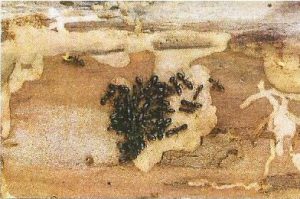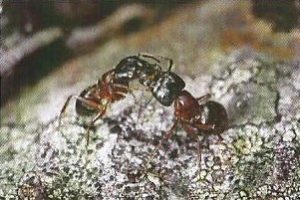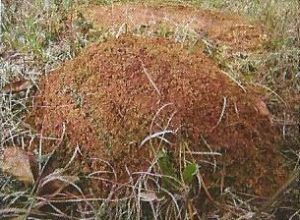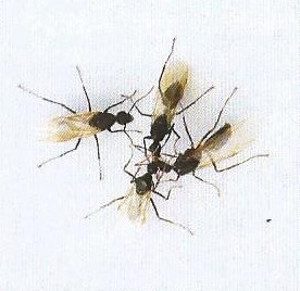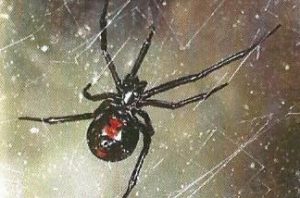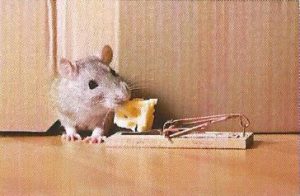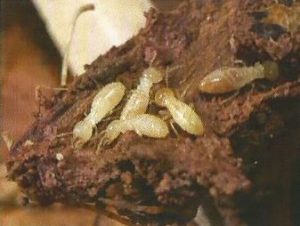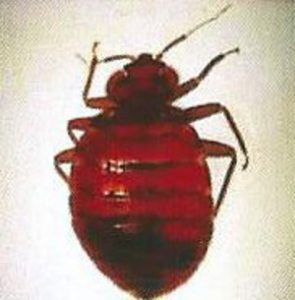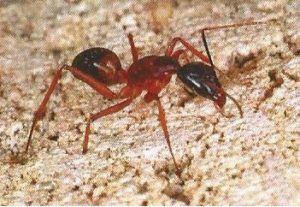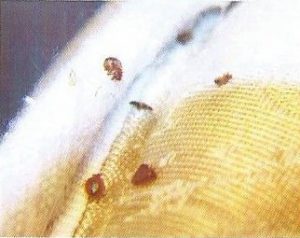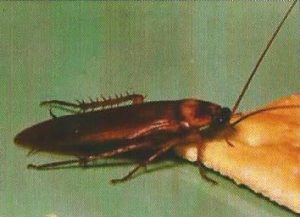Spring Pests
Carpenter Ants
Carpenter Ant Identification
There are several species of carpenter ants that may be found infesting homes and other buildings. Normally workers are black, or red and black, in color; and range in size from 3/8 to 1/2 inch. Winged queen ants may be as large as one inch. However, size is not a reliable characteristic for identifying carpenter ants. There is one species with workers no larger than 3/16 inch.
What they eat
Carpenter ants feed on sources of protein and sugar. Outdoors, carpenter ants feed on living and dead insects. They are also very attracted to honeydew, a sweet liquid produced by aphids and scale insects. Aphids and scales feed on trees, shrubs, and other plants. Indoors, carpenter ants feed on meats and pet food, as well as syrup, honey, sugar, jelly, and other sweets. Carpenter ants DO NOT eat wood. They remove wood as they create galleries and tunnels for nesting.
Most foraging is done at night between sunset and midnight during spring and summer months. Sometimes workers travel up to 100 yards from a nest in search of food. It is during this search that they may get into houses by searching along the foundation or along a tree branch that is touching the roof. Carpenter ants also interact with our houses when they travel back and forth between their main nest, which must be persistently damp and thus is usually outdoors, and their satellite nests, which may be on the outside surfaces of houses (porches, decks, etc.) or may be in walls, doors or other hollow spaces indoors (see explanation below).
Where they live
There are two types of carpenter ant nests: parent colonies and satellite colonies.
Parent colonies are typically established outdoors in wood including rotting trees, tree roots, and logs or boards lying on or buried may also nest in moist or decayed wood inside buildings. Wood decay may be caused by exposure to water leaks, condensation, or poor air circulation. Nests have been found behind bathroom tiles; around tubs, sinks, showers, and dishwashers; under roofing, in attic beams, and under subfloor insulation; and in hollow spaces such as doors, curtain rods, and wall voids. Areas around windows and where wood parts touch the foundation may be prone to infestation. Carpenter ants may also nest in foam insulation, in moist tree stumps, or in the ground.
Damage
Carpenter ants damage wood by excavating and creating galleries and tunnels for their nest. These areas are clean, i.e. they do not contain sawdust or other debris, and are smooth, with a well sanded appearance.
The damage to wood structures is variable. The longer a colony is present in a structure, the greater the damage that can be done. Structural wood can be weakened when carpenter ant damage is severe.
Detection
Signs that indicate an active nest is nearby include small piles of coarse sawdust or wood shavings, or consistent indoor sightings of large numbers of worker ants, i.e. 20 or more. Also, large numbers of winged ants indoors is evidence of an indoor nest; carpenter ants swarm from late winter through spring. Pay attention to areas where steady moisture is or has been a problem; firewood stored in an attached garage, next to the foundation, along an outside wall, or in a basement; areas around the plumbing or vent entrances; and trees with branches overhanging the house. These are possible entry points and sources of carpenter ant nests.
Sound detection may be helpful in locating a nest. An active colony may make a dry, rustling sound that becomes louder if the colony is disturbed. This sound, thought to be a form of communication, is made with the mandibles (jaws) and is not related to wood chewing. When trying to detect carpenter ants, tap the suspected area and then press an ear to the surface in order to hear any sound. Pest management professionals may use a stethoscope similar to what a medical doctor uses to locate a nest. If one nest is found, watch for evidence of additional nests. More than one nest may be present in a structure.
Prevention
An important method for preventing carpenter ant problems indoors is to eliminate high moisture conditions that are attractive to them. Also, replace any moisture-damaged wood. Be careful to prevent moisture in wood or lumber that is stored in a garage or near the house and, if possible, elevate this wood to allow air circulation.
Store firewood as far away from buildings as possible. Remove tree and shrub stumps and roots. Trim branches that overhang the home so these branches don’t contact the house, including roof and eaves. Also, prune branches that touch electrical lines or other wires that are connected to the house; carpenter ants can travel from branches to lines and use them like a highway to buildings. For more information on eliminating Carpenter Ants give us a call.
Spring / Summer Pests
Spiders
Except for poisonous spiders, such as the black widow and the brown recluse (which are not indigenous to our area), spiders are generally fairly harmless to humans. When it’s important to eliminate spiders, chemical control is used, along with destruction of webs and eggs. Since they feed on insects, measures that eliminate unwanted insects will also reduce spider populations.
Fall Pests
Rodents
Rodents consume and contaminate food. They also gnaw on electrical wires, wooden structures and tear insulation in walls and ceilings for nesting. Rodents can also transmit disease to humans, pets, and livestock.
The presence of mice and rats is usually detected by the damage they cause to food and structures by their droppings and by their nests. Treatment involves eliminating all entry points and population reduction through primarily the use of traps.
Year-Round Pests
Bedbugs
Bites & Concerns
Bed bugs usually bite people at night while they are sleeping. They feed by piercing the skin with an elongated beak through which they withdraw blood. Engorgement takes about 3 to 10 minutes, yet the person seldom knows they are being bitten. Bed bugs normally do not reside on people like head or body lice. Immediately after feeding, they crawl off and reside elsewhere to digest their meal. Symptoms after being bitten vary with the individual. Many develop an itchy red welt or localized swelling within a day or so of the bite. Others have little or no reaction, and in some people the reaction is delayed. Unlike flea bites that occur mainly around the ankles, bed bugs feed on any skin exposed while sleeping (face, neck, shoulders, back, arms, legs, etc.). The welts and itching are often wrongly attributed to other causes, such as mosquitoes. For these reasons, infestations may go a long time unnoticed and can become quite large before being detected. The likelihood of bed bugs increases if the effected individual has been traveling, or had acquired used beds or furnishings before symptoms started to appear. Bed bugs are also suspected if you wake up with itchy bites you did not have when you went to sleep. It is important to recognize that not all bites or bite-like reactions are due to bed bugs. Confirmation requires finding and identifying the bugs themselves, which often requires the help of a professional.
A common concern with bed bugs is whether they transmit diseases. Although bed bugs can harbor pathogens in and on their bodies, transmission to humans is considered unlikely. Their medical signification is chiefly limited to the itching and inflammation from their bites. Antihistamines and corticosteroids may be prescribed to reduce allergic reactions and antiseptic or antibiotic ointments to prevent infection. Though not known to carry diseases, bed bugs can severely reduce quality of life by causing discomfort, sleeplessness, anxiety, and embarrassment.
Throw Out The Bed?
Eliminating bed bugs from beds can be challenging. If there are holes or tears in the fabric, the bugs and eggs may be inside, as well as outside. There are also restrictions on how beds can be treated with pesticides. For these reasons, companies sometimes recommend that beds be discarded, especially when heavily infested or in poor condition. Another option is to encase both the mattress and box spring in a protective cover, available through retail outlets or pest control firms. Once the cover is installed and zipped shut, any bugs which happen to be inside are entombed and eventually will die. Encasements also help protect newly purchased beds and make it easier to spot and destroy any bugs residing on the outer surface during subsequent services. Encasements will not, however, keep bed bugs from crawling onto a bed and biting a sleeping person. Some companies treat seams, tufts and crevices of bed components with insecticides, but they usually will not spray bed sheets, blankets, or clothing, which should be laundered. Vacuuming and steaming further help to eliminate bugs and eggs from beds, but afford no residual protection and may not kill bed bugs hidden inside the box spring or mattress.
Description and Habits
Bed bugs are small, brownish, flattened insects that feed solely on the blood of animals. The common bed bug, Cimex lectularious, is the species most adapted to living with humans. It has done so since ancient times. Adult bed bugs are about 3/16″ long and reddish brown, with oval, flattened bodies (see photo). They are sometimes mistaken for ticks or cockroaches. The immature (nymphs) resemble the adults, but are smaller and lighter in color. Bed bugs do not fly, but can move rapidly over floors, walls, ceilings and other surfaces. Female bed bugs lay their eggs in secluded areas, depositing up to five a day and 500 during a lifetime. The eggs are tiny, whitish, and hard to see on most surfaces without magnification. Under favorable conditions (70-80°F), the bugs can complete development in as little as a month, producing three or more generations per year. Cooler temperatures or limited access to blood extends the development time. Bed bugs are resilient. Nymphs can survive months without feeding and the adults for more than a year.
Controlling Infestations
Bed bugs are challenging pests to control. Since they can hide in so many places, treatments must be thorough and elimination is not always a certainty. In most cases, it will be prudent to enlist the services of a professional. Experienced pest control firms know where to look for bed bugs and have an assortment of management tools at their disposal. Owners and occupants have an important role and will need to assist the professional. Affording access for inspection and treatment is crucial and excess clutter will have to be removed. Belongings strewn about rooms afford many places for bed bugs to hide and can impede inspection and treatment. Since bed bugs can disperse throughout a building, it often will be necessary to inspect adjoining rooms and apartments.
Infested and infestation-prone bedding and garments will need to be bagged and laundered (120°F minimum) since these items cannot be treated with insecticides. On items that can not be laundered, ask your pest control professional for more information on ridding these items of bed bugs.
At times it may be necessary to throw out infested items, especially beds and upholstered furniture. Knowledgeable pest control firms are able to advise clients on what can stay and what should go. When infested items are discarded, bagging or wrapping them prevents dislodgement of bugs en route to the trash.
For best results, in addition to treatment do the following.
• Reduce and remove clutter from the room.
• Dispose of infested items that can be discarded.
• Encase or bag articles that may be infested, but will not be laundered or discarded.
• Remove bedding, clothing, and other items that may be laundered or dry cleaned. Wash and dry on “high heat” dryer setting to achieve a temperature of 120°F minimum.
• Be certain to check in harborages that offer the bed bug isolation and darkness.
Roaches
Cockroaches spread human disease by depositing diseased organisms on food and utensils. The American cockroach, which comes into contact with human excrement in sewers or with pet droppings, may transmit bacteria that cause Salmonella and Shigella. German cockroaches are believed to be capable of transmitting disease causing organisms such as Stapylococcus, hepatitis, and coliform bacteria. They also have been implicated in the spread of typhoid and dysentery. Recent studies have found a strong association between the presence of cockroaches and increases in the severity of asthma symptoms in individuals who are sensitive to cockroach allergens.
